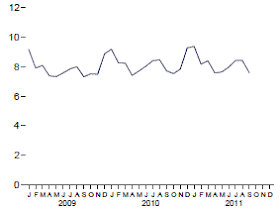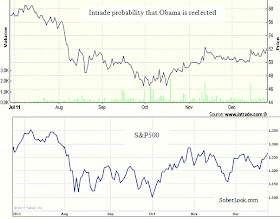To understand the issues faced by China and the steps the nation is planning to take, one needs to look no further than the country's official press. It's a bit like corporate press releases - one should read them with a healthy level of skepticism, yet the tone, the timing, and some of the content can provide good insight.
We start with the following quote from Wei Jianguo, secretary-general, Center for International Economic Exchanges:
Xinhua: For China, the year of 2012 will be the most "unpredictable, complicated, grim and difficult" year since the financial crisis three years ago... "We should get ready for trade deficit next year..."
...
China should also prepare for trade wars, as many countries are working to boost exports to protect themselves amid the dim global economy, he added.
China's officials certainly had made downbeat statements about the economy before, but for a statement to be this negative, the Party is trying to get a message out. The bosses are starting to get quite concerned about the state of China's economy. This statement says: get ready for hard times ahead, but know they are all caused by external factors, such as "dim global economy" and "trade wars".
What may prompt the Chinese leadership to turn so negative on China's growth?
There are multiple and complex issues facing China, but one of the most troubling is a potentially unprecedented correction in the real estate market.
Council on Foreign Relations: According to the property agency Homelink, new home prices in Beijing dropped 35 percent in November alone. And the free fall may continue for some time. Centaline, another leading property agency, estimates that developers have built up 22 months' worth of unsold inventory in Beijing and 21 months' worth in Shanghai.
A crash of this magnitude is clearly an unwelcome event for Party officials as they begin to prepare to deal with this issue. A 35% correction in a month feels like a panic, but this event has been in the making for some time. A
glut of development projects and
easy money available for developers (both debt and equity) had been widely discussed over two years ago. In fact this may not be unique to China, with "bubble" property and other asset markets correcting across several nations of Asia (again
discussed over two years ago).
The economic numbers coming out of China, though sometimes suspect, clearly show signs of deceleration. It started with a fairly rapid monetary policy tightening to fight inflation resulting in the M1 money supply growth dropping recently below 8%.
 |
| China M1 Growth (Bloomberg) |
Now we also see signs of a decline in growth of credit, particularly loans for fixed asset development. It's interesting to note that both the money supply measure and the fixed asset loan growth peaked around the same time - in late 2009 to early 2010.
 |
| Growth in Loans for Fixed Asset Development (Bloomberg) |
In the last two years, as banks have tightened credit to China's property developers (chart above), these firms tapped the capital markets in order to raise debt capital via bond issuance. But recently, particularly in the wake of the Sino Forest fiasco, investors are beginning to demand unsustainably high premium to own Chinese developers' debt. As an example consider the Evergrande Group, one of China's largest and and "asset rich" developers. A newly issued bond by Evergrande, the 9.25%, 5-year note now trades at 70 cents on the dollar with an over 20% yield. In fact the yield spiked above 26% during the Sino Forest scare, as investors were dumping all Chinese bonds, but had since recovered. The yield however continues to climb with uncertainty about property markets escalating.
 |
| Evergrande 9.25%, 5-year bond yield (Bloomberg) |
This is by no means unique as can be seen in another example - Greentown, also a large and well known property developer. The 9% bonds maturing in just two years are extremely volatile, currently trading at 71 cents on the dollar with a yield of over 30%.
 |
| Greentown 9% bonds maturing 11/2013 - yield (Bloomberg) |
This means that these developers are now not only cut off from significant new lending, but also effectively shut out of the capital markets and new bond issuance. It is unclear how these developers will be able to pay back their debt, if the property markets seize up. This will not only hurt the bond holders, many of whom are outside of China, but may deal a severe blow to China's banking sector that is awash with debt to property developers.
As developers begin to struggle, the property markets are having a knock-on effect on the broader economy. As an example, the steel production industry is beginning to slow markedly (the bulk of steel produced in China is used in construction). The chart below shows pig iron output dropping off at the rate similar to 2008. Note that pig iron is the raw (carbon rich) iron that is in the earliest stage of refining. Reduced orders/demand would first show up in the earliest stages of production. Prices on pig iron also declined rapidly, from 3900 to 3200-3500 CNY/metric tonne in a matter of two months.
 |
| China's total pig iron output monthly, 10000 tons (Bloomberg, Antaike Information Development) |
Other areas of the economy are showing signs of strain as well.
Council on Foreign Relations: Chinese steel production -- driven in large part by construction -- is down 15 percent from June, and nearly one-third of Chinese steelmakers are now losing money. Chinese radio reports that half of all real estate agents in the southern city of Shenzhen have closed up shop. According to Centaline, more than 100 local government land auctions failed last month, and land sale revenues in Beijing are down 15 percent this year. Without them, local governments have no way to repay the heavy loans they have taken out to fund ambitious infrastructure projects, or the additional loans they will need to keep driving GDP growth next year.
In a few cities, such as coastal Wenzhou and coal-rich Ordos, the collapse in property prices has sparked a full-blown credit crisis, with reports of ruined businessmen leaping off building rooftops; some are fleeing the country.
As the "Dutch tulip" style property correction is making its way through the broader economy, China's leaders are looking to implement solutions to address this economic downturn. Their ultimate concern continues to be the
risk of social unrest.
Council on Foreign Relations: Crowds of owners who had recently bought apartments at full price converged on sales offices throughout the city, demanding refunds. Some angry investors went on a rampage, breaking windows and smashing showrooms.
Here are some of the government's initiatives aimed at heading off the effects of this economic downturn - directly from China's official media:
1. Rapidly expand credit to medium and small businesses.
Xinhua: The Chinese government should especially give support to medium and small businesses as they would go through a hard time when the E.U. market starts to shrink, leaving them no time for a business transformation.
2. Improve domestic demand and increase incomes - particularly for the poor.
Xinhua (a different article): With the external demand waned, the Chinese government has attempted to turn to domestic consumers to take up the slack. The country vows to expand domestic demand next year and increase residents' income, especially for disadvantaged groups.
3. Improve social security and affordable housing.
Xinhua...the government also needs to improve its social security system as well as increase construction of affordable houses and public rental houses.
The dirty secret of China's property development boom has been the fact that these were largely luxury investment properties, homes that most ordinary Chinese could not afford. It is not surprising therefore that the focus shifted to affordable housing. China's government currently has enormous financial resources at its disposal (such as tax cuts, monetary easing which has
already started, etc.), that will allow the nation to soften some of the blow from this inevitable economic downturn. But it's unclear just how severe the downturn will turn out to be and the support for the economy would only be possible if social unrest does not become a problem. 2012 will be a decisive year for China and many of its trading partners.
SoberLook.com


















































